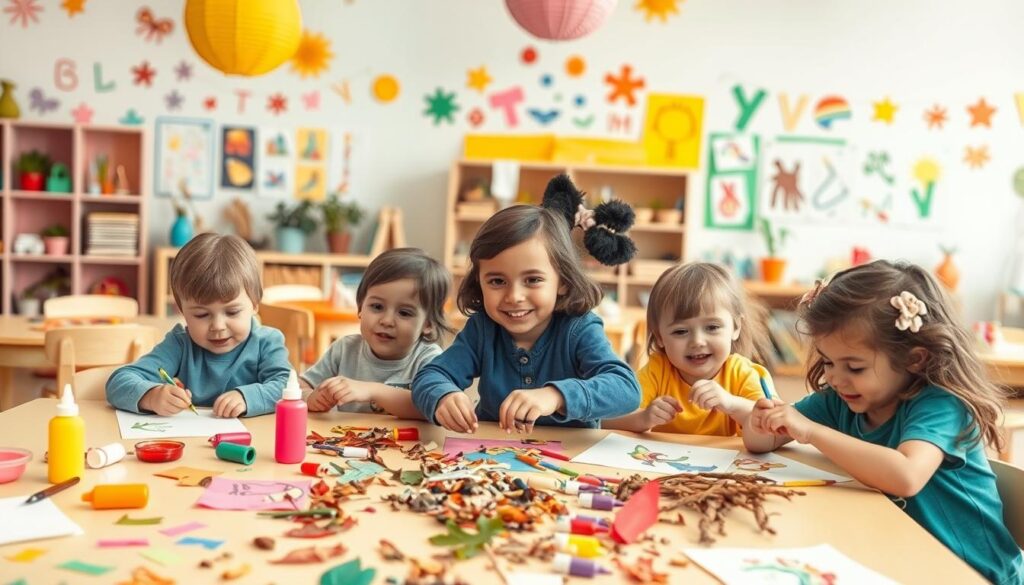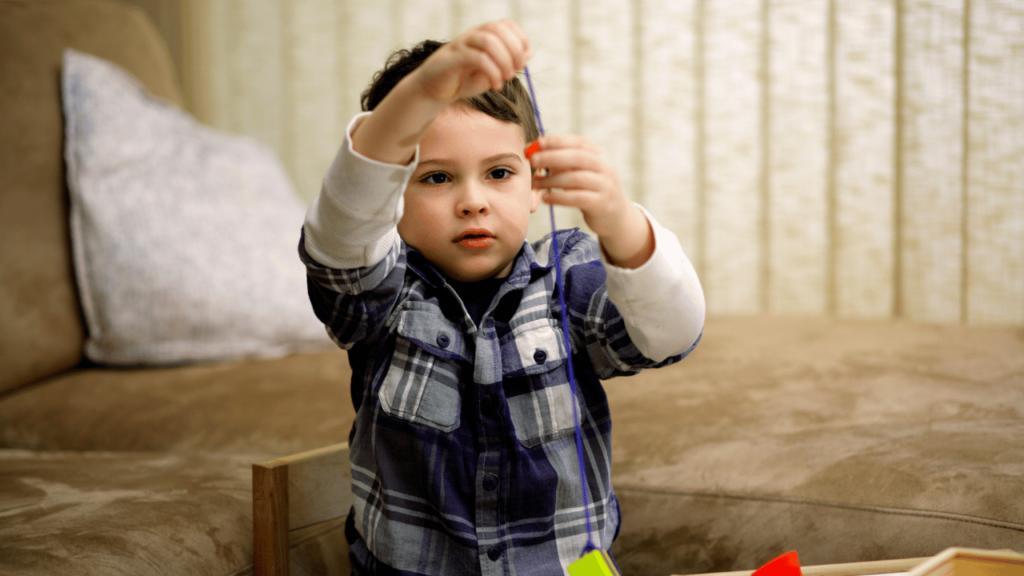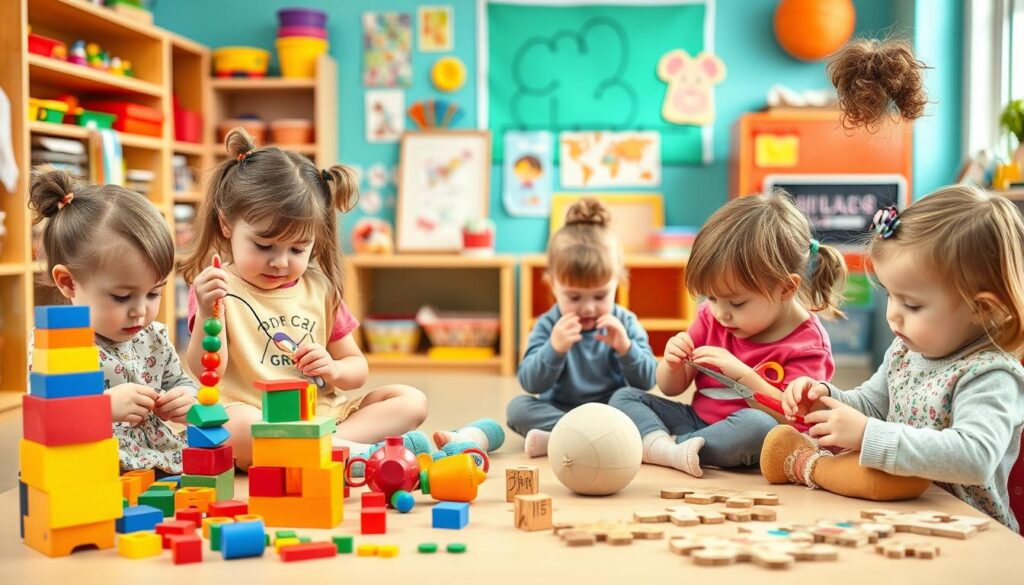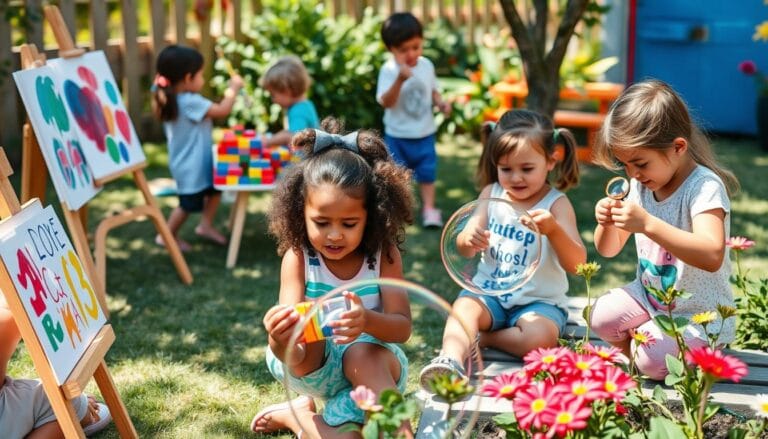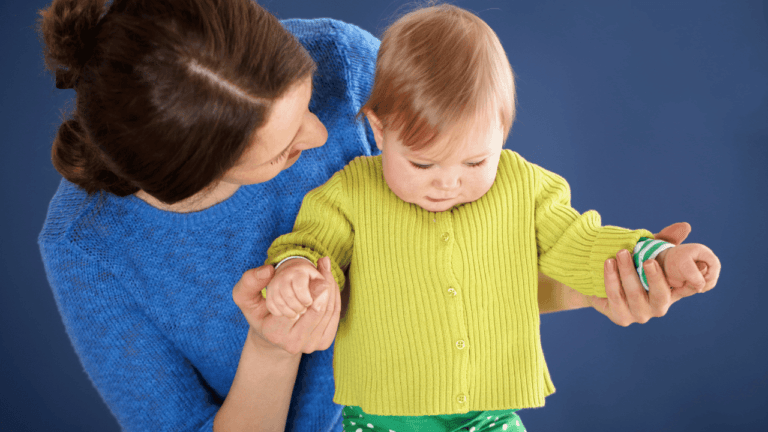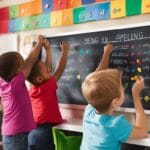
Fun Activities for Preschoolers Inspire Young Minds
It’s key to keep Activities for Preschoolers engaged with fun and learning activities. These activities should spark their curiosity and creativity. They help kids learn important skills like socializing, fine motor control, and problem-solving.
Circle time is a big part of preschool. It’s a group activity that helps kids learn and grow. Through stories, songs, and movement, circle time is fun and educational. It also helps kids feel part of a community.
When picking activities, remember kids have short attention spans. Mix sensory play, art, music, outdoor fun, and role-playing. This variety keeps them excited about learning. It also helps them grow and develop in a fun way.
Key Takeaways
- Activities for Preschoolers should inspire young minds and foster creativity
- Circle time is a crucial part of the daily routine, promoting learning and social skills
- Interactive tasks during circle time keep preschoolers engaged and build a sense of community
- Incorporate a variety of activities to cater to different interests and learning styles
- Age-appropriate activities nurture preschoolers’ growth and development
Introduction to Preschool Activities
Preschool is a magical time of exploration and growth. Young minds start their educational journey here. It’s key to give them a preschool curriculum that boosts their creativity and love for learning. Studies show over 70+ editable and printable templates for preschool activities, keeping kids both entertained and educated.
Preschool offers a variety of fun and educational activities. Kids can play interactive math games or go on alphabet treasure hunts. Creative first-day ideas can make the year exciting, helping kids make friends and learn classroom rules in a fun way.
Preschool activities spark a child’s imagination and help them grow. Activities like making school bus collages or cereal necklaces improve fine motor skills and creativity. They also offer a chance for sensory exploration, laying the groundwork for a lifelong love of learning.
“Play is often talked about as if it were a relief from serious learning. But for children, play is serious learning. Play is really the work of childhood.” – Fred Rogers
A well-designed preschool curriculum does more than just teach academics. Back-to-school activities help build teamwork and social skills. Group crafts, like painting or play-dough projects, teach kids to work together and respect each other’s ideas.
| Activity Type | Number of Activities | Key Benefits |
|---|---|---|
| Back-to-School Season Fun | 38 | Enhances fine motor skills, encourages creativity, facilitates learning |
| Pre-Kindergarten Packet | 4 | Engages young learners, prepares for kindergarten |
| Classroom Dynamics | Varies | Fosters friendships, establishes rules, teaches coordination and cooperation |
As preschoolers start their educational journey, they need a safe, nurturing place. A diverse range of activities, from safety role-plays to cooking, enriches their learning. These early years are crucial for a successful academic career and a lifelong love of learning.
Sensory Play Activities for Preschoolers
Sensory play is key for preschoolers. It lets them explore, learn, and use their senses. Activities range from sensory bins to playdough and slime. These fun experiences help them grow.
Sensory play boosts preschoolers in many ways. It improves motor skills and language. It also engages all senses, calming and focusing children.
Sand and Water Play
Sand and water play is a hit with preschoolers. It’s a hands-on way to learn about textures and temperatures. Tools like scoops help with fine motor skills and spark imagination.
It also encourages problem-solving and teamwork when kids play together.
Texture Exploration
Texture exploration is another great activity. It lets kids feel different textures like silk and sandpaper. This helps them learn to describe what they feel.
It can be part of art, nature walks, or a fun activity on its own.
| Texture | Material | Sensory Experience |
|---|---|---|
| Smooth | Silk, satin, glass beads | Cool, slippery, soft |
| Rough | Sandpaper, tree bark, pumice stone | Gritty, coarse, abrasive |
| Soft | Feathers, cotton balls, velvet | Fluffy, gentle, soothing |
| Bumpy | Bubble wrap, corrugated cardboard, textured balls | Uneven, ridged, stimulating |
Sensory Bins
Sensory bins are fun for all ages. They’re filled with materials like rice and water beads. Kids can explore and learn with different themes.
They help with fine motor skills and spark imagination.
Sensory play is not just fun; it’s a fundamental way for preschoolers to learn about the world around them and develop essential skills that will serve them throughout their lives.
Adding sensory play to your preschooler’s day is beneficial. It helps them engage their senses and grow. Embrace the mess and watch them thrive.
Art and Craft Activities for Preschoolers
Arts and crafts are great for preschoolers. They help grow creativity, imagination, and fine motor skills. The Artful Parent has over 35 fun crafts for home or school.
Painting and Drawing
Painting and drawing are key for preschoolers. They learn about colors, shapes, and textures. Give them paints, brushes, and paper to explore.
Try fun activities like pom-pom painting or Q-Tip dragonflies. It keeps them excited about making art.
Collage Making
Collage making boosts fine motor skills and creativity. Use paper, stickers, and natural items for colorful collages. Projects like mosaic animals or rainbow art inspire imagination.
| Art Activity | Skills Developed | Materials Needed |
|---|---|---|
| Painting and Drawing | Creativity, fine motor skills, color recognition | Washable paints, watercolors, paintbrushes, sponges, finger paints, drawing paper |
| Collage Making | Fine motor skills, creativity, spatial awareness | Paper scraps, stickers, fabric pieces, natural elements, glue |
| Sculpture and 3D Art | Fine motor skills, spatial awareness, problem-solving | Playdough, modeling clay, recycled materials, pipe cleaners, popsicle sticks |
Sculpture and 3D Art
Sculpture and 3D art are great for building skills. Use playdough, clay, and recycled items for creativity. Building structures or making robots are fun projects.
Art allows children to practice a wide range of skills, including aesthetic, scientific, interpersonal, and practical interactions.
Arts and crafts are essential for preschoolers. They support learning and creativity. Embrace the mess and watch your child’s imagination grow.
Music and Movement Activities for Preschoolers
Music activities for preschoolers are great for boosting their creativity and physical activity. They can do simple songs or games with props and instruments. This helps them grow in many ways.
Musical Hula Hoops is a fun game where kids walk around hula hoops to music. It teaches teamwork and helps them move together. Action songs like “Head, Shoulders, Knees, and Toes” mix fun tunes with physical actions. This improves coordination and memory.
The Statues or Freeze Game is another hit. Kids dance when music plays and freeze when it stops. It’s great for listening skills and letting them show off their dance moves. Changing traditional songs into new versions can spark their imagination and movement.
Using props like scarves or rhythm sticks makes music activities even more exciting. Scarf dancing helps kids move and recognize rhythm. Rhythm sticks add beats, improving their hearing and getting them to move more.
Music and movement help kids with coordination, listening, and creativity. They have fun and express themselves.
Parents can help by giving kids materials like scarves or dancing with them. Activities like Paper Plate Dancing or Find the Beat teach basic music concepts. This helps kids understand rhythm and tempo.
Studies show that music activities for preschoolers are very beneficial. They improve their thinking, feelings, and physical health. A review in the NIH National Library of Medicine talks about how music helps kids grow.
| Activity | Benefits |
|---|---|
| Musical Hula Hoops | Encourages teamwork and movement |
| Action Songs | Combines physical activities with music |
| Statues/Freeze Game | Promotes listening skills and self-expression |
| Scarf Dancing | Fosters coordination and rhythm recognition |
| Rhythm Sticks | Enhances auditory skills and encourages exercise |
Offering a variety of music and movement activities meets different interests and learning styles. It promotes healthy habits and helps kids appreciate music. Making music a regular part of their lives supports their growth and creates a happy, supportive environment.
Outdoor Play and Gross Motor Skill Development
Outdoor activities are key for preschoolers to grow their gross motor skills. These skills are vital for daily tasks, playground fun, and sports. Experts say to start early, but remember, kids grow at their own pace.
Outdoor play lets kids test their muscles and learn important physical skills. They build strength, balance, and coordination through play.
Activities like walking, playing ball, and swimming are great for preschoolers. Swimming is especially good, working out all big muscles. Water play also helps with gross motor skills.
Obstacle Courses
Obstacle courses are a great way to improve gross motor skills outside. Kids can climb, jump, balance, and crawl. This helps their muscles and coordination.
Playground equipment also offers chances for kids to be active. It helps them develop their gross motor skills.
Nature Exploration
Nature walks and scavenger hunts are fun ways to explore. Kids can collect items and watch plants and animals. Walking can be more fun with music, stories, or games.
Scavenger hunts with different movements like marching or hopping are great. They boost physical activity and gross motor skills.
Outdoor Games
Games like tag and hide-and-seek get kids moving. Soft balls help improve throwing and catching. Hula hoops and jumping ropes also help with gross motor skills.
Studies have shown that children who engage in regular physical activity often have better memory, attention, and problem-solving skills.
Gross motor activities improve hand-eye coordination and body awareness. These skills are essential for everyday tasks and sports. Regular activity also keeps kids healthy and reduces disease risk.
| Outdoor Activity | Gross Motor Skills Developed |
|---|---|
| Walking | Balance, coordination, endurance |
| Playing ball | Throwing, catching, kicking, hand-eye coordination |
| Swimming | Strength, endurance, coordination |
| Obstacle courses | Climbing, jumping, balancing, crawling |
| Scavenger hunts | Marching, skipping, jogging, dancing, hopping, crawling, tip-toeing |
Activities for Preschoolers to Develop Fine Motor Skills
It’s important for preschoolers to practice fine motor skills. These skills are needed for writing, cutting, and buttoning. Fine motor skills activities help strengthen their hands and fingers. This improves coordination and dexterity.
Puzzles and Manipulatives
Puzzles and toys help preschoolers with hand-eye coordination and problem-solving. Use puzzles with large pieces for small hands. Lakeshore’s Giant Alphabet Beads are great for this.
Stacking toys, shape sorters, and blocks also help. They improve fine motor skills and encourage creativity.
Some fun activities include:
- Building with small blocks
- Putting together simple puzzles
- Playing board games that require moving pieces
- Snapping together blocks or connecting toys
Lacing and Threading
Lacing and threading activities boost dexterity and concentration. Use lacing cards, beads, or sewing cards for kids to practice. These activities are key for writing and precise tasks later.
The Spider Web Game is a hit for kids. It mixes lacing and threading with fun, imaginative play.
Other activities that help with fine motor skills include:
| Activity | Materials | Benefits |
|---|---|---|
| Weaving | Ribbons, strips of paper, or yarn | Improves dexterity and concentration |
| Beading | Large beads and pipe cleaners or string | Enhances hand-eye coordination and pincer grip |
| Sewing | Plastic needles, yarn, and punch cards | Develops fine motor control and precision |
By doing puzzles, playing with manipulatives, and practicing lacing and threading, preschoolers get ready for school. These activities are key for their future success.
Dramatic Play and Imagination Activities
Dramatic play and imagination activities are key for preschoolers’ growth. They let kids try out different roles and feelings in a safe, creative space. With 86% of preschoolers using pretend play to learn, it’s clear how important these activities are.
Teachers know how valuable dramatic play is. They use settings like Airport and Cookie Shop Bakery in class. This helps kids learn life skills and boosts their creativity.
Pretend Play Scenarios
Pretend play offers many benefits for preschoolers. It helps them learn new words and improve communication. It also boosts their organizational skills and attention span.
| Dramatic Play Setting | Observed Benefits |
|---|---|
| Workshop | 72% of educators found improved fine motor skills and creativity |
| Food Market | 68% increase in children’s multicultural awareness |
| Bakery Center | 80% of preschoolers showed improved collaborative skills |
| Hospital Play | 75% increase in children’s understanding of empathy and caregiving |
| Camp Out | 63% of preschoolers displayed enhanced problem-solving skills |
Storytelling and Puppetry
Storytelling and puppetry boost imagination and language skills in preschoolers. Activities like Library and Restaurant help with reading and teamwork. Puppet theater increases storytelling skills by 65%.
Dramatic play allows children to make sense of the world around them, develop empathy, and practice essential life skills in a safe and imaginative environment.
By offering various dramatic play centers, educators help preschoolers explore different roles and settings. From being community helpers to creating art, the options are endless. These activities help kids develop important skills for life.
STEM Activities for Preschoolers
Introducing preschoolers to science, technology, engineering, and math (STEM) through fun activities is great. It sparks their curiosity and love for learning. Hands-on STEM activities help young minds think critically and solve problems.
Preschoolers can explore many STEM concepts. They can mix colors and see chemical reactions. They can also build with toys or recyclables.
They can learn about ice and salt to understand states of matter. Or, they can grow seeds in a jar to learn about plants.
Math is part of STEM for preschoolers. They learn to sort, pattern, and count objects. They can use educational apps or build simple robots.
These activities improve motor skills and encourage creativity and teamwork.
“STEM activities provide a strong educational foundation for preschoolers, preparing them for future challenges and instilling a lifelong love of learning.”
STEM activities boost preschoolers’ self-esteem and confidence. They feel proud of their accomplishments. This early exposure prepares them for their future education.
| STEM Concept | Example Activity | Skills Developed |
|---|---|---|
| Chemistry | Baking soda and vinegar experiments | Observation, prediction, cause and effect |
| Biology | Dissecting a flower | Fine motor skills, classification, scientific inquiry |
| Physics | Marshmallow catapults | Problem-solving, force and motion, trial and error |
| Engineering | Building bridges with recyclables | Creativity, spatial awareness, structural integrity |
| Math | Sorting and patterning objects | Categorization, sequencing, logical thinking |
Preschool STEM activities cover many topics. They include liquid density, chemical reactions, and plant biology. These activities are hands-on, keeping preschoolers engaged and motivated.
Libraries, community centers, and schools offer free STEM classes and workshops. This makes it easy for parents to introduce STEM to their preschoolers. By participating, young learners start a journey of discovery that shapes their future and sparks a lifelong passion for learning.
Conclusion
Engaging Activities for Preschoolers are key for young minds to grow. They help spark creativity, critical thinking, and problem-solving. Parents and educators can lay a strong foundation for learning by offering a variety of experiences.
From sensory play to outdoor adventures, these activities let preschoolers discover their interests. They help kids express themselves and build confidence. This is crucial for their development.
STEM activities and dramatic play boost cognitive skills. Children learn to make connections and test ideas. This environment encourages curiosity and imagination, preparing them for school and beyond.
Creating a stimulating environment is our duty as parents and educators. We must prioritize engaging preschool activities. This way, we help our children succeed and develop a love for learning.
For more tips on supporting young minds, visit Developing Listening Skills. It offers strategies for auditory learners and improving communication in preschoolers.


